
Commercial Meat Grinder Buying Guide
Commercial meat grinders are designed to efficiently grind and process meat, making them ideal for butcher shops, delis, restaurants, and other commercial kitchens. This equipment comes in a variety of sizes and configurations to suit different production needs. From small countertop models suitable for low-volume operations to large industrial-grade machines capable of processing hundreds of pounds of meat per hour, there is a commercial meat grinder to fit every business's requirements. Discover the different types of meat grinders available for your establishment and the various factors you should consider to find the best commercial meat grinder for your establishment:
Shop All Commercial Meat Grinders
When it comes to commercial meat grinders, the power source is a crucial consideration that can significantly impact efficiency and productivity.
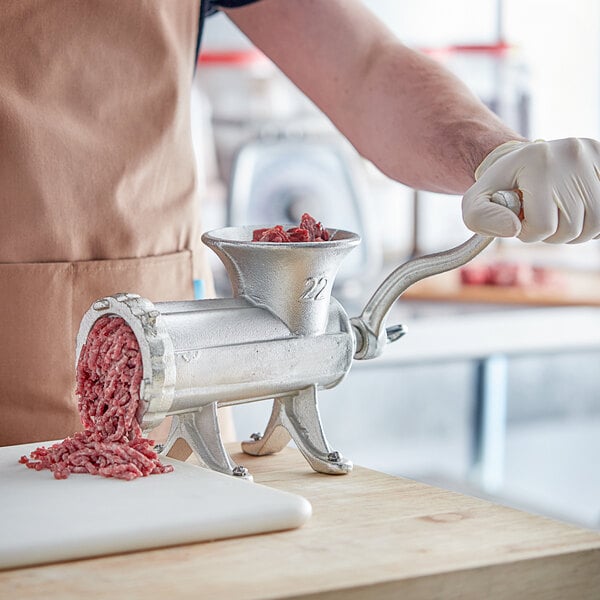
Manual Meat Grinders
Manual meat grinders mount to your table or countertop and are designed for low-volume use. Because of their relatively small capacity and the need to turn the crank by hand, this type of grinder isn't used often in a commercial setting.
Purchasing Considerations:
- Use a table clamp to stay in place, as some models won't attach to a thick table.
- Not intended for frequent commercial-level use.
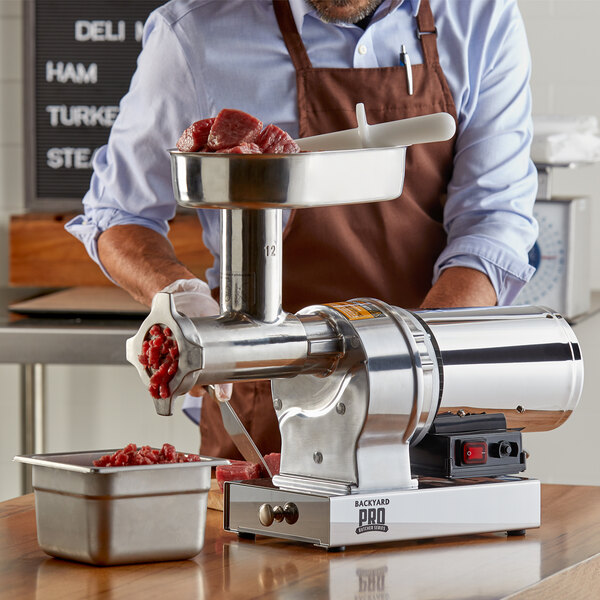
Electric Meat Grinders
Electric meat grinders come in a variety of sizes, from small countertop units all the way up to large, high-output floor mounted models that are best suited for meat processing facilities or busy butcher shops.
It's important to pay attention to the number of pounds of meat a particular meat grinder can process per minute (or per hour) when comparing models. If you purchase a unit that can't keep up with your output requirements, you'll shorten its life and negatively impact your own productivity.
Purchasing Considerations:
- Match the output of the machine to your business needs
- Pay attention to the materials and construction of the grinder; stainless steel is dishwasher safe and resists corrosion
Horizontal Meat Grinders
Horizontal food cutters, more commonly known as buffalo choppers, are a specialized type of electric grinder that shred chicken, pork, and other meats that you don't want finely ground. They also work great for making menu items like coleslaw, potato salad, and chicken salad because you can add seasonings and sauces as you're cutting the meat or vegetables. Some models even boast a powered take-off hub (PTO) where you hook up a meat grinder or vegetable slicer attachment to have the best of both worlds!
Purchasing Considerations:
- Pay attention to safety features; the blade is more exposed on this type of unit
- Evaluate space; these models can take up a bit more countertop space than a traditional countertop meat grinder
Consider the volume of meat you plan to grind, the frequency of use, and your specific production requirements when choosing the type of meat grinder that best suits your commercial kitchen. Each type offers unique benefits and features to enhance your meat grinding process and meet the demands of your business.

Light-Duty Meat Grinders
Light-duty meat grinders are designed for low-volume applications such as small delis, restaurants, or catering businesses. These units are ideal for occasional use and are capable of grinding small quantities of meat at a time.
- Compact in size
- Affordable
- Ideal for small volumes of meat

Medium-Duty Meat Grinders
These meat grinders are suitable for establishments with moderate meat grinding needs, such as butcher shops, restaurants, or grocery stores. Medium-duty units are more powerful than light-duty grinders and can handle larger quantities of meat at a faster rate.
- Built to withstand frequent use
- Equipped with robust motors and compontents
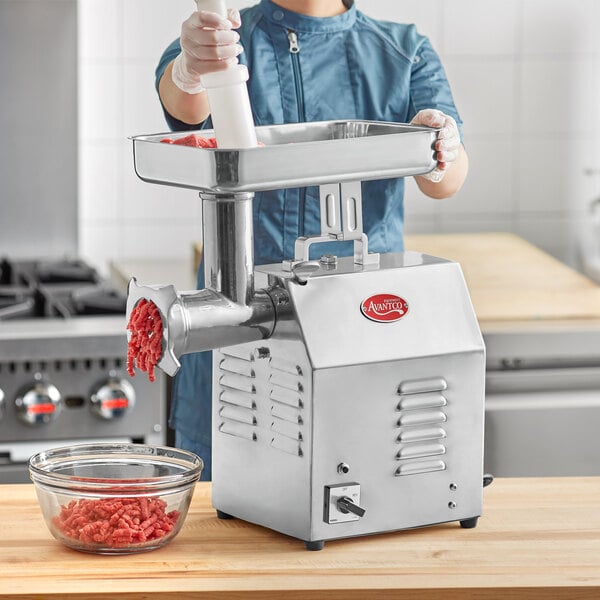
Heavy-Duty Meat Grinders
Heavy-duty meat grinders are designed for high-volume commercial settings such as large butcher shops, meat processing facilities, or industrial kitchens. These units are built to handle continuous and heavy-duty grinding tasks, making them ideal for processing large quantities of meat quickly and efficiently.
- Constructed with durable materials and powerful motors
- Effectively processes large quantities of meat without overheating or slowing down
Commercial meat grinders come in various sizes, typically categorized by the diameter of the grinding plates. The most common sizes for commercial use are #12, #22, and #32. These numbers correspond to the diameter of the grinder plates in inches.
Choosing the right size meat grinder is essential to ensure efficient and effective meat processing in your commercial kitchen. Consider the volume of meat you will be grinding, the frequency of use, and the types of products you will be making when selecting the appropriate size grinder for your business.
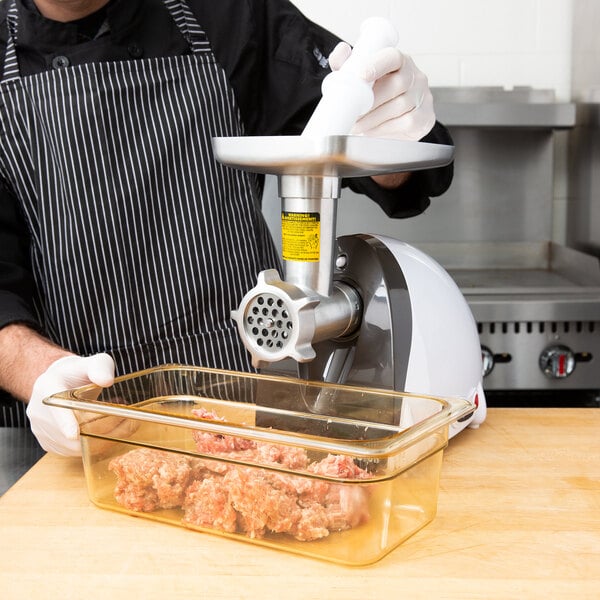
When using a meat grinder, follow these tips and tricks to enhance the performance of your meat grinder, achieve better results, and enjoy delicious freshly ground meat for your culinary creations:
- Chill your grinding plates, knife, feed tube, and auger in a freezer or ice bath before grinding a batch of meat.
- Cut the meat into evenly sized chunks and feed it through the funnel gently; don't force it.
- A sharp cutting knife is a must. Replace dulled ones for better performance.
- Thoroughly clean and sanitize all components immediately after use. Stainless steel components are dishwasher safe.
- For cast aluminum or cast iron components, try storing them in a small food pan with some cornstarch. It will absorb excess moisture.
- Use a food-safe lubricant to maintain and protect all moving parts.
- Do not feed grinders animal bones.
- Don't take your meat out of the refrigerator until you're ready to grind it.
Having the right meat grinder parts and attachments can make a significant difference in the efficiency and versatility of your machine. Invest in the these quality parts and attachments to help maximize the effectiveness your commercial meat grinder.

- Grinder Plates - These plates come in various sizes, with different hole diameters to achieve different textures of ground meat. Coarse plates are ideal for items like hamburgers and sausages, while fine grinder plates are better suited for items like pates and spreads.
- Sausage Tubes - These attachments allow you to easily stuff ground meat into casings to make sausages. Sausage tubes come in different sizes to accommodate various casing sizes, giving you the flexibility to create different types of sausages with your meat grinder.
- Meat Plungers - Meat plungers help push the meat down the feeder tube and into the grinder, safely reducing the risk of jams or clogs in the machine.
- End Attachments - End attachments can include items like cheese graters, vegetable slicers, and pasta makers, expanding the range of tasks your meat grinder can perform.
Related Resources

Meat Slicers Buying Guide
In this meat slicing guide, we will explore everything you need to know about meat slicers , helping you improve the efficiency of your foodservice establishment and select the best meat slicer for your needs! Be sure to check out our commercial meat slicer reviews as well!
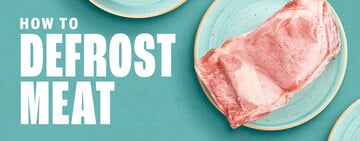
How to Defrost Meat
Defrosting meat is an essential part of food preparation. Often, people are in a hurry to get their meals cooked and resort to quick thawing methods, such as using hot water or leaving the package on the counter all day. However, these methods are not safe and may lead to foodborne illnesses. Raw or cooked meat must be kept at a safe temperature during storage and preparation. We'll discuss the different methods of defrosting meat and the correct way to do it to ensure food safety . Best Way to Defrost Meat The best way to thaw meat is in the refrigerator over time. If you need to expedite the process, you can also defrost food in cold water or the microwave. These methods help you keep your food out of the "danger zone" as the temperature

Commercial Meat Grinder Reviews
Compare machine specifications and customer reviews to choose which commercial meat grinder is ideal for you. All of our grinders are built to withstand daily use in a commercial kitchen, so you can crank out your famous meats. Whether you're making a few hamburger patties per week or hundreds of sausages per day, you can find a meat grinder that will match your level of output. From smaller hand-crank models to ones with electric motors, find the best option for your kitchen with our meat grinder comparison.
- Topics 1346
- Industrial 55
- Troubleshooting Guides 21
- Restaurant Management 128
- Bar Management 55
- Catering Tips 35
- Bakery Management 42
- Food Trucks & Concessions 49
- Advertising & Marketing 37
- Eco-Friendly Tips 11
- Facility Layout & Design 41
- Coffee Shop Tips 28
- Installation & Maintenance 51
- Janitorial & Pest Control 30
- Safety & Sanitation 88
- Startup Tips 104
- Menu Design 10
- Kitchen & Cooking Tips 81
- Hospitality Management 23
- Pizza & Sandwich Shop Tips 36
- Smallwares 37
- Food Prep 88
- Tabletop Items 17
- Disposables 22
- Calculators & Tools 6
- Consumables 52
- Warewashing & Laundry 18
- Cooking Equipment 90
- Food Storage & Refrigeration 51
- Beverage Equipment 34
- Office Supplies 6
- Resource Type
- In-Depth Articles272
- Buying Guides296
- How-Tos93
- Product Reviews77


